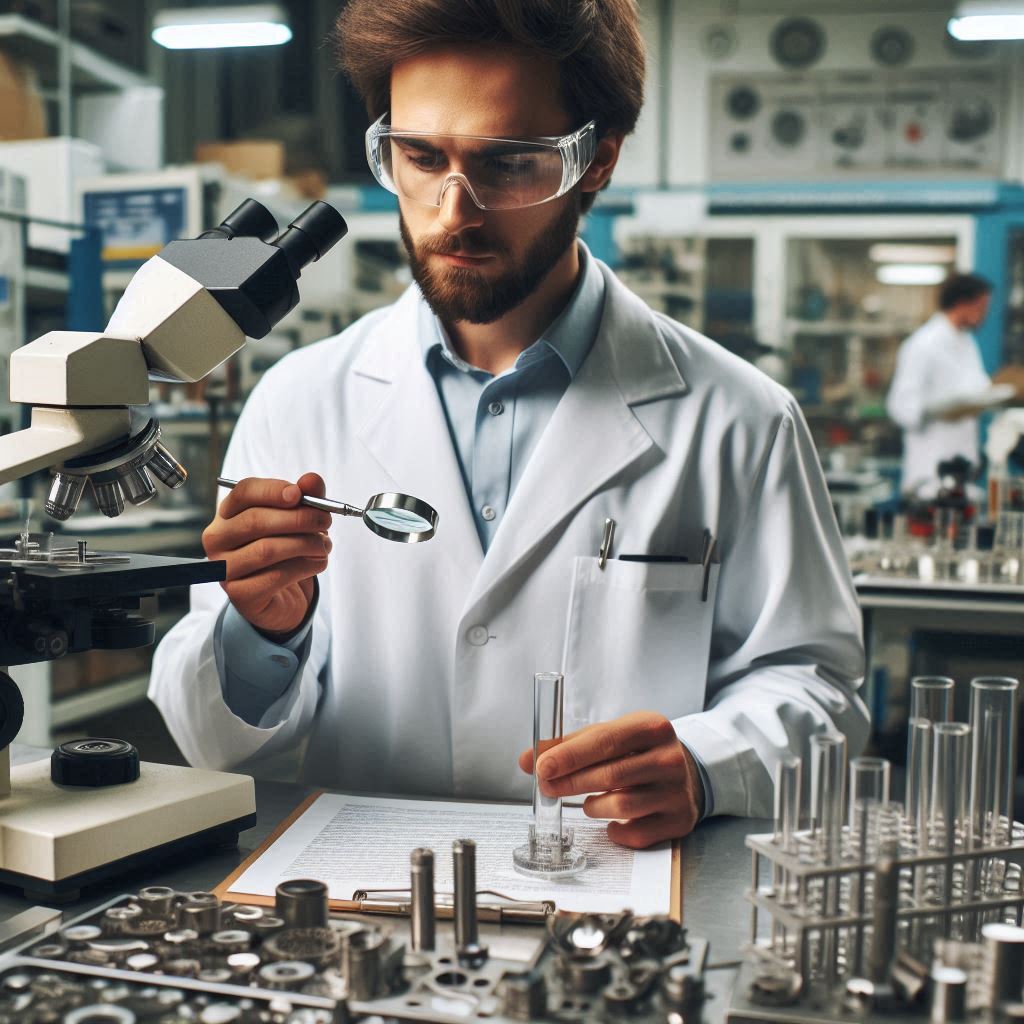Introduction
Overview of Biomedical Engineering
Biomedical engineering combines engineering principles with medical sciences to create solutions for healthcare.
This field focuses on developing medical devices, diagnostics, and treatments to improve patient care.
Definition of Prosthetics
Prosthetics are artificial devices that replace missing body parts, restoring functionality and enhancing the quality of life for individuals with limb loss.
These devices can range from simple limbs to advanced bionic arms and legs.
Importance of Biomedical Engineering in Developing Prosthetics
Biomedical engineers play a crucial role in developing advanced prosthetics.
They design, test, and refine these devices to ensure they are safe, effective, and tailored to individual needs.
The collaboration between biomedical engineers, healthcare professionals, and patients leads to innovative solutions that improve mobility and independence.
Advances in materials, biomechanics, and robotics have significantly enhanced the capabilities of prosthetics, making them more lifelike and functional.
As technology continues to evolve, biomedical engineering will remain essential in advancing prosthetic development and improving patient outcomes.
History of biomedical engineering in prosthetics
Milestones in the Development of Prosthetics
The history of prosthetics dates back to ancient Egypt, where early prosthetic devices were crafted from materials like wood and metal.
The notable discovery of a wooden toe dating back to 950-710 B.
C. showcases the ingenuity of early prosthetic designs.
In the 16th century, Ambroise Par‘, a French surgeon, revolutionized prosthetics by developing artificial limbs with locking knees and harnesses.
His work laid the foundation for modern prosthetic engineering.
The 20th century marked significant milestones in prosthetic development.
The advent of World War I and II accelerated advancements as demand for functional prosthetics surged.
The introduction of lightweight materials, such as aluminum, and the development of suction sockets improved the comfort and usability of prosthetics.
In the 1970s, the emergence of myoelectric prosthetics, which utilize electrical signals from muscles to control movement, marked a major breakthrough.
Evolution of Prosthetic Technology
The evolution of prosthetic technology has been driven by biomedical engineering innovations.
Early prosthetics were rudimentary and often uncomfortable.
Today, advanced materials and technologies have transformed prosthetics into highly functional devices.
The use of carbon fiber has made prosthetics lighter and more durable.
Additionally, the integration of microprocessors has enhanced the precision and adaptability of prosthetic limbs.
One of the most significant advancements in prosthetic technology is the development of bionic limbs.
These devices mimic natural limb movements and provide users with a greater range of motion.
Bionic limbs often incorporate sensors that detect muscle signals, allowing for intuitive control.
The incorporation of robotics has also played a pivotal role in improving the functionality of prosthetics.
Robotic prosthetics can perform complex movements, offering users increased dexterity and control.
Impact of Biomedical Engineering on Prosthetic Advancements
Biomedical engineering has had a profound impact on the advancements in prosthetics.
Engineers apply principles of biomechanics, materials science, and electronics to develop prosthetics that are more functional, comfortable, and tailored to individual needs.
The interdisciplinary nature of biomedical engineering allows for the integration of various technologies, resulting in more sophisticated and effective prosthetic devices.
Advances in materials science have led to the use of lightweight and durable materials, such as carbon fiber and titanium, which improve the comfort and longevity of prosthetics.
Biomedical engineers also focus on the development of more realistic prosthetics by incorporating lifelike aesthetics and sensory feedback systems.
These systems provide users with a sense of touch and proprioception, enhancing the overall functionality of the prosthetic.
The collaboration between biomedical engineers, healthcare professionals, and patients is essential for the continuous improvement of prosthetics.
Feedback from users informs the design and development process, ensuring that prosthetics meet the evolving needs of individuals with limb loss.
As technology continues to evolve, the role of biomedical engineering in prosthetic advancements will remain crucial, driving innovations that improve the quality of life for countless individuals.
Types of prosthetics
Overview of Different Types of Prosthetics
Prosthetics have transformed the lives of individuals with limb loss, offering diverse solutions to meet varied needs.
There are several types of prosthetics, each designed for specific purposes.
Upper limb prosthetics include devices like prosthetic arms and hands.
These enable individuals to perform daily tasks such as eating, writing, and lifting objects.
Lower limb prosthetics, such as prosthetic legs and feet, restore mobility, allowing users to walk, run, and even engage in sports.
Facial prosthetics, including eyes, ears, and noses, help individuals regain their appearance and confidence after trauma or surgery.
Each type of prosthetic plays a vital role in improving the quality of life for its users.
Materials Used in Prosthetic Manufacturing
The materials used in prosthetic manufacturing are critical to the functionality and comfort of the devices.
Common materials include lightweight metals, plastics, and silicone.
Lightweight metals, like titanium and aluminum, are used for their strength and durability.
These metals provide structural support without adding excessive weight.
Plastics are often used in the sockets and joints of prosthetics.
They offer flexibility and resilience, ensuring the prosthetics can withstand regular use.
Silicone is commonly used for its skin-like properties, making prosthetics look and feel more natural.
It is often used in facial prosthetics and the outer layers of limb prosthetics.
The choice of materials significantly impacts the effectiveness and comfort of prosthetics.
Benefits and Limitations of Each Type of Prosthetic
Upper limb prosthetics offer users the ability to perform complex tasks.
They can include advanced features like sensors and motors for better functionality.
However, these devices can be expensive and require regular maintenance.
Lower limb prosthetics restore mobility, allowing individuals to engage in physical activities.
They range from basic walking aids to high-performance running blades.
The main limitation is the need for proper fitting and adjustment to ensure comfort.
Facial prosthetics help individuals regain their appearance after injury or surgery.
They are custom-made to match the person’s skin tone and facial structure.
The primary limitation is that they need to be replaced periodically due to wear and changes in the user’s appearance.
Each type of prosthetic offers significant benefits, improving the quality of life for users.
However, the limitations must be addressed to ensure optimal performance and user satisfaction.
Continuous advancements in materials and technology are helping to overcome these challenges, making prosthetics more effective and accessible.
Biomedical engineering plays a crucial role in these advancements, driving innovation and improving outcomes for individuals with limb loss.
Read: Decoding the Ethics & Responsibilities of US Civil Engineers
Biomedical engineering techniques in prosthetic design
Biomedical engineering plays a crucial role in the field of prosthetics, revolutionizing the way artificial limbs are designed and function.
Here, we will explore some of the key techniques used in prosthetic design to enhance their performance and comfort for users.
3D Printing Technology in Creating Custom Prosthetics
One of the most significant advancements in prosthetic design is the adoption of 3D printing technology.
This innovative approach allows for the creation of customized prosthetics tailored to each individual’s unique anatomy.
By using precise measurements and digital imaging, engineers can design prosthetic limbs that fit perfectly and offer optimal functionality.
Integration of Sensors for Improved Functionality
Biomedical engineers are incorporating sensors into prosthetic devices to improve their functionality and responsiveness.
By integrating sensors that can detect muscle activity and movement patterns, prosthetics can be programmed to mimic natural limb movements more accurately.
This technology helps users regain a sense of control and dexterity in their everyday tasks.
Use of Advanced Materials for Durability and Comfort
Another essential aspect of prosthetic design is the use of advanced materials that offer durability and comfort to users.
Biomedical engineers are constantly exploring new materials that are lightweight, flexible, and long-lasting.
These materials not only make prosthetics more comfortable to wear but also ensure they can withstand daily wear and tear without compromising their functionality.
Biomedical engineering continues to push the boundaries of prosthetic design, making significant advancements in creating devices that closely resemble natural limbs in both appearance and functionality.
By leveraging cutting-edge technologies and innovative materials, engineers are transforming the field of prosthetics and improving the quality of life for amputees worldwide.
Read: Top Cities for Electrical Engineering Jobs in America
Rehabilitation and prosthetic fitting
When it comes to rehabilitation and prosthetic fitting, biomedical engineers play a crucial role in designing prosthetics that meet specific patient needs.
Role of Biomedical Engineers in Designing Prosthetics
Biomedical engineers use their expertise to create prosthetics that are customized to fit each patient’s unique requirements.
They take into account factors such as the type of amputation, the residual limb shape, and the patient’s lifestyle and goals.
By working closely with healthcare providers and patients, biomedical engineers can design prosthetics that offer the best possible function and comfort.
This personalized approach helps improve the overall quality of life for individuals using prosthetics.
Importance of Proper Fitting and Alignment
Proper fitting and alignment are essential for ensuring the optimal functionality of prosthetics.
Biomedical engineers collaborate with prosthetists to ensure that the prosthetic device fits securely and comfortably on the patient’s residual limb.
By focusing on alignment and fit, biomedical engineers help minimize discomfort, prevent skin breakdown, and enhance the overall performance of the prosthetic device.
This attention to detail is crucial for ensuring that patients can move naturally and confidently with their prosthetics.
Rehabilitation Process for Patients Adjusting to Prosthetics
The rehabilitation process for patients adjusting to prosthetics is a crucial part of their journey towards regaining mobility and independence.
Biomedical engineers work alongside physical therapists, occupational therapists, and prosthetists to support patients throughout this process.
During rehabilitation, patients receive training on how to use their prosthetic devices effectively and safely.
Biomedical engineers may make adjustments to the prosthetic design based on feedback from patients and therapists to optimize comfort and performance.
Furthermore, biomedical engineers play a key role in developing innovative rehabilitation technologies that can enhance the rehabilitation experience for patients.
These technologies can include virtual reality simulations, sensor-equipped prosthetics, and biofeedback systems that provide real-time information on prosthetic use.
Therefore, the contribution of biomedical engineers to prosthetics goes beyond designing and creating devices.
They play a vital role in ensuring that prosthetics are tailored to individual needs, fitted correctly for optimal functionality, and integrated seamlessly into the rehabilitation process.
By working collaboratively with patients and healthcare providers, biomedical engineers help enhance the quality of life and mobility for individuals living with limb loss.
Transform Your Career Today
Unlock a personalized career strategy that drives real results. Get tailored advice and a roadmap designed just for you.
Start NowRead: US Tech Hubs Beyond Silicon Valley: Emerging Cities
Discover More: How to Choose the Right Transportation Engineering Path
Challenges in Prosthetic Development
Biomedical engineers play a crucial role in the development of prosthetics, creating innovative solutions that improve the quality of life for individuals with limb loss or mobility impairments.
Through advances in technology and design, these engineers have been able to enhance the functionality and comfort of prosthetic devices, allowing users to regain independence and live more fulfilling lives.
Despite the significant progress made in the field of prosthetics, there are still several challenges that biomedical engineers must address in order to continue improving the effectiveness and accessibility of these devices.
Some of the key challenges in prosthetic development include:
Cost Considerations in Creating Advanced Prosthetics
One of the major obstacles in the development of advanced prosthetics is the high cost associated with designing and manufacturing these devices.
Cutting-edge technology and materials can significantly increase the production costs, making these devices inaccessible to many individuals who could benefit from them.
Biomedical engineers are constantly working to find ways to reduce the cost of prosthetics without compromising on quality or functionality.
By leveraging economies of scale, streamlining production processes, and exploring new materials and technologies, engineers can make advanced prosthetics more affordable and accessible to a wider range of users.
Ethical Considerations in Prosthetic Design
Another challenge in prosthetic development is ensuring that devices are designed and implemented in an ethical manner.
This includes considering issues such as patient consent, privacy, and the potential impact of prosthetics on a user’s physical and mental well-being.
Biomedical engineers must carefully navigate these ethical considerations when developing prosthetic devices, prioritizing the safety and autonomy of the user.
By incorporating ethical guidelines and principles into the design process, engineers can create prosthetics that not only enhance functionality but also respect the dignity and rights of the user.
Accessibility Issues for Underserved Populations
Accessibility is a critical consideration in prosthetic development, as individuals in underserved populations may face barriers to obtaining and using these devices.
Factors such as geographic location, socioeconomic status, and cultural beliefs can impact access to prosthetic care and support.
Biomedical engineers must work to address these accessibility issues by developing prosthetic solutions that are culturally sensitive, affordable, and easy to use.
By collaborating with healthcare providers, community organizations, and policymakers, engineers can ensure that prosthetic services are accessible to all individuals in need, regardless of their background or circumstances.
In the end, while there are challenges in prosthetic development, biomedical engineers are dedicated to overcoming these obstacles and continuing to advance the field.
By addressing cost considerations, ethical issues, and accessibility barriers, engineers can create prosthetic devices that improve the quality of life for individuals with limb loss and mobility impairments.
Read: The Journey: How to Become an Architect in the USA.

Current trends in prosthetic technology
When it comes to prosthetics, biomedical engineering has made significant contributions to the field.
By combining medical knowledge with engineering principles, biomedical engineers have been able to innovate and improve prosthetic devices, ultimately enhancing the quality of life for amputees.
One of the current trends in prosthetic technology is the integration of artificial intelligence into prosthetic design.
Artificial intelligence algorithms can analyze data from sensors on the prosthetic device to make adjustments in real time, improving functionality and comfort for the user.
AI in Prosthetic Design
Artificial intelligence allows prosthetic devices to adapt to the user’s movements and preferences, providing a more natural and personalized experience.
For example, AI can adjust the prosthetic grip strength based on the object being held or the user’s activity level.
Another trend in prosthetic technology is the use of robotics to enhance prosthetic movement.
Robotic prosthetics use motors and sensors to mimic the movements of a natural limb, allowing for more precise control and fluid motion.
These advancements have enabled users to perform complex tasks with greater ease and efficiency.
Robotics in Prosthetic Movement
Robotic prosthetics can be programmed to learn and adapt to the user’s gait and muscle signals, improving coordination and balance.
This technology has revolutionized prosthetic care, offering users a higher level of mobility and independence.
Bionic prosthetics represent another breakthrough in prosthetic technology.
These devices incorporate advanced materials and technologies to create prosthetic limbs with enhanced functionality and aesthetics.
Bionic prosthetics can simulate the movements of a natural limb more accurately, providing users with a more lifelike experience.
Development of Bionic Prosthetics
Bionic prosthetics often include sensory feedback systems that enable users to feel sensations such as pressure and temperature.
This feedback can help users better interact with their environment and improve their overall quality of life.
In a nutshell, current trends in prosthetic technology demonstrate the incredible impact of biomedical engineering on the field of prosthetics.
Through the integration of artificial intelligence, robotics, and bionic technologies, biomedical engineers continue to push the boundaries of what is possible in prosthetic design, ultimately improving the lives of amputees around the world.
Gain More Insights: Success Stories: Women in Telecommunications Technician Roles
Learn More: Lean Manufacturing and Industrial Engineering
Impact of prosthetics on quality of life
Testimonials from Individuals Using Prosthetics
Prosthetics profoundly impact the lives of individuals who use them.
John, a prosthetic leg user, shares his story.
After a car accident, he faced the challenge of adjusting to life without a leg.
With his prosthetic, John regained his mobility and independence.
He returned to his job, resumed hobbies, and regained his confidence.
Similarly, Maria, who lost an arm to illness, received a prosthetic arm.
This device allowed her to perform daily tasks independently.
She describes the prosthetic as a life-changer, giving her the ability to live more fully.
Psychological Benefits of Prosthetic Devices
Prosthetics offer significant psychological benefits.
They provide individuals with a sense of normalcy and control over their lives.
For many, using a prosthetic reduces feelings of helplessness and dependency.
This boost in autonomy directly improves mental well-being.
Additionally, prosthetics can restore a person‘s self-esteem.
When people can perform tasks independently, they often feel more capable and confident.
This psychological uplift is crucial for overall mental health.
Many users report that their prosthetic helps them engage in social and professional activities.
This engagement further enhances their sense of purpose and belonging.
Social Acceptance and Inclusivity for Prosthetic Users
Social acceptance and inclusivity for prosthetic users have improved significantly.
Awareness and education play a key role in this shift.
As more people understand the capabilities and benefits of prosthetics, stigma decreases.
Communities and workplaces have become more inclusive.
Accessible design in public spaces helps prosthetic users navigate their environments more easily.
Inclusivity initiatives in schools and businesses promote acceptance.
By highlighting the abilities of prosthetic users, these initiatives foster a more inclusive society.
Many companies now design products and services with prosthetic users in mind.
This consideration ranges from sports equipment to adaptive technology.
These efforts enhance the quality of life for prosthetic users by enabling full participation in various activities.
You Might Also Like: Pros and Cons of Being a Telecommunications Technician
Find Out More: Networking Tips for Aspiring Marine Engineers
Conclusion
Biomedical engineering plays a crucial role in advancing prosthetic technology, improving the lives of individuals with limb loss.
Through innovative research and development, engineers continue to enhance prosthetic devices, making them more functional and comfortable for users.
Looking towards the future, there are exciting possibilities for prosthetic advancements.
With the integration of artificial intelligence, bionic prosthetics may become more responsive and intuitive, mimicking natural movements with greater precision.
Moreover, 3D printing technology has the potential to revolutionize prosthetic manufacturing, allowing for custom-designed devices that are both cost-effective and tailored to individual needs.
These breakthroughs have the power to significantly enhance the quality of life for amputees.
In closing, prosthetics have a profound impact on not only restoring physical function but also providing emotional and psychological benefits to users.
By leveraging the capabilities of biomedical engineering, we can continue to push the boundaries of what is possible in prosthetic development, ultimately improving the well-being and independence of individuals with limb loss.
Showcase Your Business Today
Reach thousands of readers actively exploring professional services. Publish your business profile and grow your audience now.
Publish Now[E-Books for Sale]
The Big Book of 500 High-Paying Jobs in America: Unlock Your Earning Potential
$19.99 • 500 High-Paying Jobs • 330 pages
Explore 500 high-paying jobs in America and learn how to boost your career, earn more, and achieve success!
See All 500 High-Paying Jobs of this E-Book
1001 Professions Without a Degree: High-Paying American Jobs You Can Start Now
$19.99 • 1001 Professions Without a Degree • 174 pages
Discover 1001 high-paying jobs without a degree! Unlock career tips, skills, and success strategies for just $19.99!




